When Is The Function Increasing When Given Derivative Graph
iv. Applications of Derivatives
4.five Derivatives and the Shape of a Graph
Learning Objectives
- Explicate how the sign of the first derivative affects the shape of a function's graph.
- State the first derivative test for critical points.
- Use concavity and inflection points to explain how the sign of the 2nd derivative affects the shape of a function's graph.
- Explain the concavity test for a function over an open up interval.
- Explain the relationship between a part and its first and 2d derivatives.
- State the second derivative examination for local extrema.
Earlier in this chapter we stated that if a part ![]() has a local extremum at a betoken
has a local extremum at a betoken ![]() then
then ![]() must be a critical point of
must be a critical point of ![]() Notwithstanding, a function is non guaranteed to have a local extremum at a critical indicate. For example,
Notwithstanding, a function is non guaranteed to have a local extremum at a critical indicate. For example, ![]() has a disquisitional point at
has a disquisitional point at ![]() since
since ![]() is zip at
is zip at ![]() merely
merely ![]() does not have a local extremum at
does not have a local extremum at ![]() Using the results from the previous section, we are at present able to determine whether a disquisitional point of a function actually corresponds to a local extreme value. In this section, we also see how the second derivative provides information almost the shape of a graph by describing whether the graph of a role curves upward or curves downward.
Using the results from the previous section, we are at present able to determine whether a disquisitional point of a function actually corresponds to a local extreme value. In this section, we also see how the second derivative provides information almost the shape of a graph by describing whether the graph of a role curves upward or curves downward.
The Get-go Derivative Test
Corollary 3 of the Mean Value Theorem showed that if the derivative of a office is positive over an interval ![]() then the function is increasing over
then the function is increasing over ![]() On the other hand, if the derivative of the office is negative over an interval
On the other hand, if the derivative of the office is negative over an interval ![]() then the part is decreasing over
then the part is decreasing over ![]() equally shown in the following effigy.
equally shown in the following effigy.

 At each point
At each point  the derivative
the derivative  Both functions are decreasing over the interval
Both functions are decreasing over the interval  At each point
At each point  the derivative
the derivative 
A continuous function ![]() has a local maximum at point
has a local maximum at point ![]() if and only if
if and only if ![]() switches from increasing to decreasing at point
switches from increasing to decreasing at point ![]() Similarly,
Similarly, ![]() has a local minimum at
has a local minimum at ![]() if and only if
if and only if ![]() switches from decreasing to increasing at
switches from decreasing to increasing at ![]() If
If ![]() is a continuous function over an interval
is a continuous function over an interval ![]() containing
containing ![]() and differentiable over
and differentiable over ![]() except maybe at
except maybe at ![]() the simply fashion
the simply fashion ![]() can switch from increasing to decreasing (or vice versa) at point
can switch from increasing to decreasing (or vice versa) at point ![]() is if
is if ![]() changes sign as
changes sign as ![]() increases through
increases through ![]() If
If ![]() is differentiable at
is differentiable at ![]() the just mode that
the just mode that ![]() can modify sign equally
can modify sign equally ![]() increases through
increases through ![]() is if
is if ![]() Therefore, for a function
Therefore, for a function ![]() that is continuous over an interval
that is continuous over an interval ![]() containing
containing ![]() and differentiable over
and differentiable over ![]() except possibly at
except possibly at ![]() the only way
the only way ![]() tin switch from increasing to decreasing (or vice versa) is if
tin switch from increasing to decreasing (or vice versa) is if ![]() or
or ![]() is undefined. Consequently, to locate local extrema for a function
is undefined. Consequently, to locate local extrema for a function ![]() nosotros look for points
nosotros look for points ![]() in the domain of
in the domain of ![]() such that
such that ![]() or
or ![]() is undefined. Call back that such points are called disquisitional points of
is undefined. Call back that such points are called disquisitional points of ![]()
Note that ![]() demand not have a local extrema at a disquisitional point. The critical points are candidates for local extrema simply. In (Effigy), we show that if a continuous function
demand not have a local extrema at a disquisitional point. The critical points are candidates for local extrema simply. In (Effigy), we show that if a continuous function ![]() has a local extremum, it must occur at a critical point, but a function may non have a local extremum at a disquisitional point. We evidence that if
has a local extremum, it must occur at a critical point, but a function may non have a local extremum at a disquisitional point. We evidence that if ![]() has a local extremum at a critical point, then the sign of
has a local extremum at a critical point, then the sign of ![]() switches as
switches as ![]() increases through that point.
increases through that point.
Using (Figure), we summarize the main results regarding local extrema.
This result is known equally the first derivative test.
We tin summarize the kickoff derivative test every bit a strategy for locating local extrema.
At present let'south look at how to utilize this strategy to locate all local extrema for particular functions.
Using the Outset Derivative Examination to Find Local Extrema
Apply the outset derivative exam to detect the location of all local extrema for ![]() Use a graphing utility to ostend your results.
Use a graphing utility to ostend your results.
Utilize the first derivative test to locate all local extrema for ![]()
Solution
![]() has a local minimum at -2 and a local maximum at three.
has a local minimum at -2 and a local maximum at three.
Using the Starting time Derivative Exam
Employ the showtime derivative examination to find the location of all local extrema for ![]() Use a graphing utility to confirm your results.
Use a graphing utility to confirm your results.
Use the first derivative test to notice all local extrema for ![]()
Concavity and Points of Inflection
Nosotros at present know how to determine where a function is increasing or decreasing. Nonetheless, at that place is another result to consider regarding the shape of the graph of a function. If the graph curves, does it curve up or curve downwards? This notion is called the concavity of the function.
(Figure)(a) shows a function ![]() with a graph that curves upward. As
with a graph that curves upward. As ![]() increases, the slope of the tangent line increases. Thus, since the derivative increases as
increases, the slope of the tangent line increases. Thus, since the derivative increases as ![]() increases,
increases, ![]() is an increasing function. Nosotros say this role
is an increasing function. Nosotros say this role ![]() is concave upwardly. (Figure)(b) shows a office
is concave upwardly. (Figure)(b) shows a office ![]() that curves downward. Every bit
that curves downward. Every bit ![]() increases, the gradient of the tangent line decreases. Since the derivative decreases every bit
increases, the gradient of the tangent line decreases. Since the derivative decreases every bit ![]() increases,
increases, ![]() is a decreasing function. We say this function
is a decreasing function. We say this function ![]() is concave down.
is concave down.
In general, without having the graph of a part ![]() how can we determine its concavity? Past definition, a function
how can we determine its concavity? Past definition, a function ![]() is concave up if
is concave up if ![]() is increasing. From Corollary 3, we know that if
is increasing. From Corollary 3, we know that if ![]() is a differentiable function, then
is a differentiable function, then ![]() is increasing if its derivative
is increasing if its derivative ![]() Therefore, a function
Therefore, a function ![]() that is twice differentiable is concave up when
that is twice differentiable is concave up when ![]() Similarly, a function
Similarly, a function ![]() is concave down if
is concave down if ![]() is decreasing. Nosotros know that a differentiable office
is decreasing. Nosotros know that a differentiable office ![]() is decreasing if its derivative
is decreasing if its derivative ![]() Therefore, a twice-differentiable part
Therefore, a twice-differentiable part ![]() is concave down when
is concave down when ![]() Applying this logic is known as the concavity exam.
Applying this logic is known as the concavity exam.
We conclude that we can determine the concavity of a function ![]() by looking at the 2nd derivative of
by looking at the 2nd derivative of ![]() In improver, nosotros observe that a function
In improver, nosotros observe that a function ![]() can switch concavity ((Figure)). All the same, a continuous function tin can switch concavity simply at a signal
can switch concavity ((Figure)). All the same, a continuous function tin can switch concavity simply at a signal ![]() if
if ![]() or
or ![]() is undefined. Consequently, to make up one's mind the intervals where a part
is undefined. Consequently, to make up one's mind the intervals where a part ![]() is concave upward and concave downwardly, we look for those values of
is concave upward and concave downwardly, we look for those values of ![]() where
where ![]() or
or ![]() is undefined. When we have determined these points, nosotros carve up the domain of
is undefined. When we have determined these points, nosotros carve up the domain of ![]() into smaller intervals and determine the sign of
into smaller intervals and determine the sign of ![]() over each of these smaller intervals. If
over each of these smaller intervals. If ![]() changes sign as we pass through a bespeak
changes sign as we pass through a bespeak ![]() then
then ![]() changes concavity. It is important to recall that a function
changes concavity. It is important to recall that a function ![]() may not alter concavity at a betoken
may not alter concavity at a betoken ![]() even if
even if ![]() or
or ![]() is undefined. If, however,
is undefined. If, however, ![]() does alter concavity at a point
does alter concavity at a point ![]() and
and ![]() is continuous at
is continuous at ![]() we say the point
we say the point ![]() is an inflection signal of
is an inflection signal of ![]()
Testing for Concavity
We now summarize, in (Figure), the data that the first and second derivatives of a role ![]() provide virtually the graph of
provide virtually the graph of ![]() and illustrate this information in (Figure).
and illustrate this information in (Figure).
| Sign of | Sign of | Is | Concavity |
|---|---|---|---|
| Positive | Positive | Increasing | Concave up |
| Positive | Negative | Increasing | Concave down |
| Negative | Positive | Decreasing | Concave up |
| Negative | Negative | Decreasing | Concave down |
The 2nd Derivative Test
The first derivative exam provides an analytical tool for finding local extrema, merely the second derivative tin can likewise be used to locate farthermost values. Using the 2d derivative can sometimes be a simpler method than using the beginning derivative.
We know that if a continuous function has a local extrema, it must occur at a critical signal. However, a function need not take a local extrema at a disquisitional point. Hither we examine how the 2d derivative examination can be used to make up one's mind whether a role has a local extremum at a critical point. Let ![]() exist a twice-differentiable part such that
exist a twice-differentiable part such that ![]() and
and ![]() is continuous over an open interval
is continuous over an open interval ![]() containing
containing ![]() Suppose
Suppose ![]() Since
Since ![]() is continuous over
is continuous over ![]()
![]() for all
for all ![]() ((Effigy)). Then, past Corollary 3,
((Effigy)). Then, past Corollary 3, ![]() is a decreasing function over
is a decreasing function over ![]() Since
Since ![]() we conclude that for all
we conclude that for all ![]() if
if ![]() and
and ![]() if
if ![]() Therefore, by the first derivative examination,
Therefore, by the first derivative examination, ![]() has a local maximum at
has a local maximum at ![]() On the other hand, suppose there exists a point
On the other hand, suppose there exists a point ![]() such that
such that ![]() but
but ![]() Since
Since ![]() is continuous over an open interval
is continuous over an open interval ![]() containing
containing ![]() and so
and so ![]() for all
for all ![]() ((Figure)). Then, by Corollary
((Figure)). Then, by Corollary ![]() is an increasing part over
is an increasing part over ![]() Since
Since ![]() we conclude that for all
we conclude that for all ![]()
![]() if
if ![]() and
and ![]() if
if ![]() Therefore, by the outset derivative test,
Therefore, by the outset derivative test, ![]() has a local minimum at
has a local minimum at ![]()
Annotation that for case iii. when ![]() then
then ![]() may have a local maximum, local minimum, or neither at
may have a local maximum, local minimum, or neither at ![]() For case, the functions
For case, the functions ![]()
![]() and
and ![]() all have critical points at
all have critical points at ![]() In each case, the second derivative is zero at
In each case, the second derivative is zero at ![]() However, the function
However, the function ![]() has a local minimum at
has a local minimum at ![]() whereas the function
whereas the function ![]() has a local maximum at
has a local maximum at ![]() and the function
and the function ![]() does non have a local extremum at
does non have a local extremum at ![]()
Allow's now look at how to use the second derivative exam to make up one's mind whether ![]() has a local maximum or local minimum at a critical bespeak
has a local maximum or local minimum at a critical bespeak ![]() where
where ![]()
Using the 2d Derivative Test
Use the 2nd derivative to find the location of all local extrema for ![]()
We have now adult the tools we need to decide where a function is increasing and decreasing, as well as acquired an understanding of the basic shape of the graph. In the next department we discuss what happens to a part as ![]() At that point, nosotros take enough tools to provide accurate graphs of a large diverseness of functions.
At that point, nosotros take enough tools to provide accurate graphs of a large diverseness of functions.
Primal Concepts
ii. For the function ![]() is
is ![]() both an inflection betoken and a local maximum/minimum?
both an inflection betoken and a local maximum/minimum?
Solution
Information technology is not a local maximum/minimum considering ![]() does not change sign
does not change sign
iii. For the function ![]() is
is ![]() an inflection point?
an inflection point?
4. Is information technology possible for a point ![]() to be both an inflection indicate and a local extrema of a twice differentiable part?
to be both an inflection indicate and a local extrema of a twice differentiable part?
5. Why practise yous need continuity for the first derivative examination? Come up up with an example.
vi. Explain whether a concave-downwards office has to cross ![]() for some value of
for some value of ![]()
Solution
Faux; for example, ![]()
7. Explain whether a polynomial of degree 2 tin have an inflection signal.
For the following exercises, analyze the graphs of ![]() then listing all intervals where
then listing all intervals where ![]() is increasing or decreasing.
is increasing or decreasing.
8.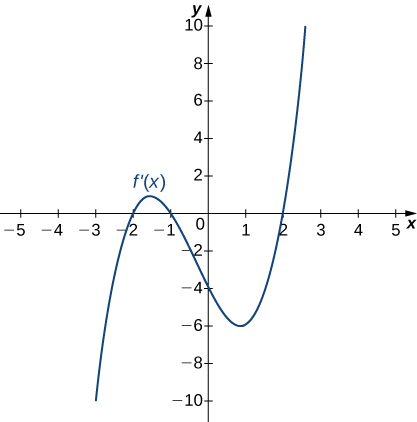
9. 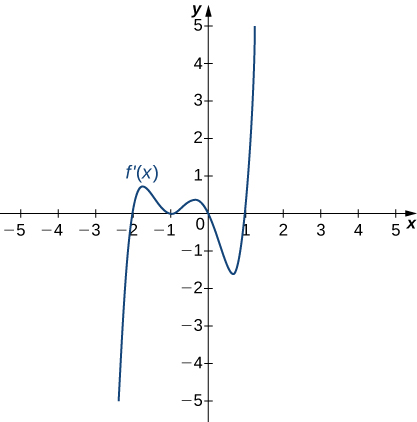
x. 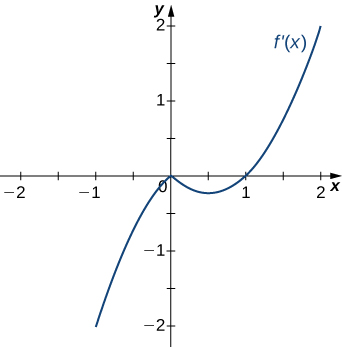
Solution
Decreasing for ![]() increasing for
increasing for ![]()
11.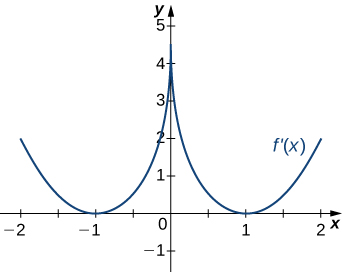
12.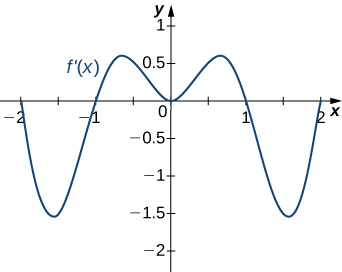
For the following exercises, analyze the graphs of ![]() and so listing all intervals where
and so listing all intervals where
-
 is increasing and decreasing and
is increasing and decreasing and - the minima and maxima are located.
xiii.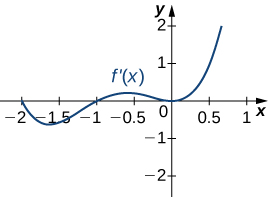
14.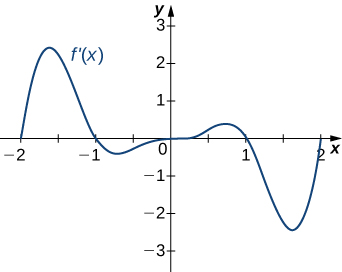
fifteen.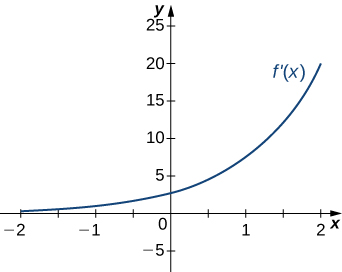
16.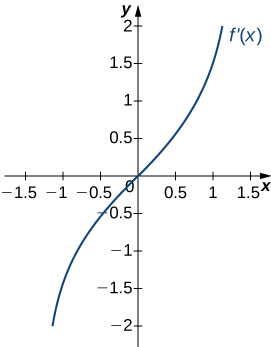
17.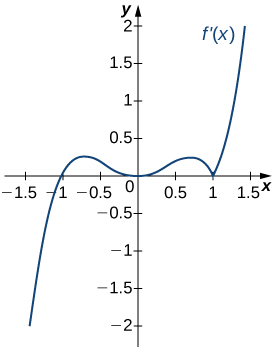
For the following exercises, analyze the graphs of ![]() then list all inflection points and intervals
then list all inflection points and intervals ![]() that are concave up and concave downwardly.
that are concave up and concave downwardly.
18.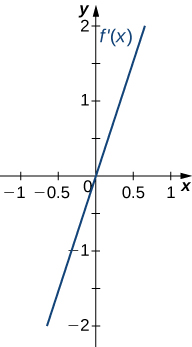
Solution
Concave up on all ![]() no inflection points
no inflection points
19.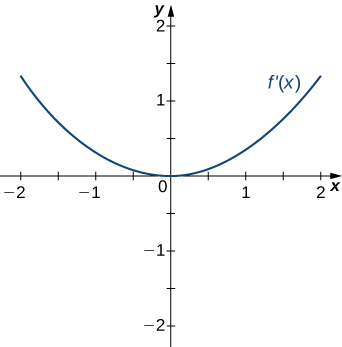
20.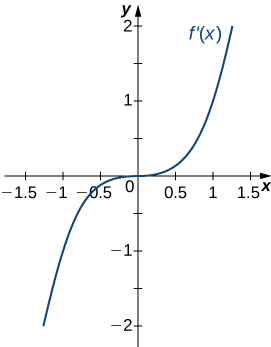
Solution
Concave upwards on all ![]() no inflection points
no inflection points
21.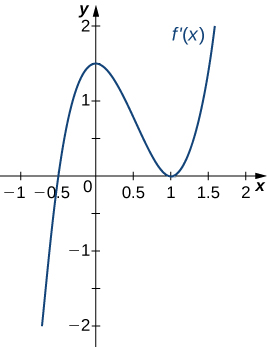
22.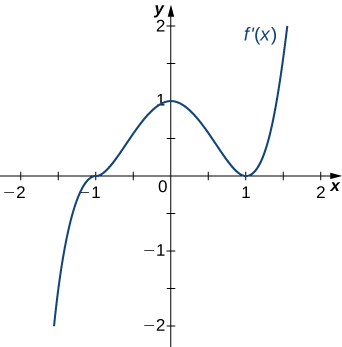
For the following exercises, draw a graph that satisfies the given specifications for the domain ![]() The role does non have to exist continuous or differentiable.
The role does non have to exist continuous or differentiable.
24. ![]() over
over ![]() over
over ![]() for all
for all ![]()
Solution
Answers will vary
26. In that location is a local maximum at ![]() local minimum at
local minimum at ![]() and the graph is neither concave upward nor concave downwardly.
and the graph is neither concave upward nor concave downwardly.
Solution
Answers will vary
For the post-obit exercises, determine
- intervals where
 is increasing or decreasing and
is increasing or decreasing and - local minima and maxima of

28. ![]() over
over ![]()
29. ![]()
For the following exercises, determine a. intervals where ![]() is concave upwards or concave downward, and b. the inflection points of
is concave upwards or concave downward, and b. the inflection points of ![]()
30. ![]()
For the post-obit exercises, determine
- intervals where
 is increasing or decreasing,
is increasing or decreasing, - local minima and maxima of

- intervals where
 is concave up and concave downwardly, and
is concave up and concave downwardly, and - the inflection points of

31. ![]()
32. ![]()
33. ![]()
34. ![]()
35. ![]()
36. ![]()
37. ![]()
For the post-obit exercises, make up one's mind
- intervals where
 is increasing or decreasing,
is increasing or decreasing, - local minima and maxima of

- intervals where
 is concave upwardly and concave down, and
is concave upwardly and concave down, and - the inflection points of
 Sketch the curve, then apply a calculator to compare your reply. If you cannot make up one's mind the exact answer analytically, utilise a calculator.
Sketch the curve, then apply a calculator to compare your reply. If you cannot make up one's mind the exact answer analytically, utilise a calculator.
38. [T] ![]() over
over ![]()
39. [T] ![]() over
over ![]()
40. [T] ![]() over
over ![]()
41. [T] ![]()
42. [T] ![]()
44. ![]() over
over ![]()
45. ![]()
46. ![]()
47. ![]()
For the following exercises, translate the sentences in terms of ![]()
48. The population is growing more slowly. Here ![]() is the population.
is the population.
Solution
![]()
49. A bike accelerates faster, but a machine goes faster. Here ![]() Bike's position minus Car's position.
Bike's position minus Car's position.
fifty. The airplane lands smoothly. Here ![]() is the plane's altitude.
is the plane's altitude.
Solution
![]()
51. Stock prices are at their meridian. Here ![]() is the stock price.
is the stock price.
52. The economy is picking upwardly speed. Hither ![]() is a measure of the economy, such as GDP.
is a measure of the economy, such as GDP.
Solution
![]()
For the post-obit exercises, consider a 3rd-degree polynomial ![]() which has the properties
which has the properties ![]() Determine whether the following statements are true or false. Justify your answer.
Determine whether the following statements are true or false. Justify your answer.
53. ![]() for some
for some ![]()
54. ![]() for some
for some ![]()
Solution
Truthful, by the Hateful Value Theorem
55. There is no absolute maximum at ![]()
56. If ![]() has three roots, then it has 1 inflection bespeak.
has three roots, then it has 1 inflection bespeak.
Solution
True, examine derivative
57. If ![]() has 1 inflection point, then it has three existent roots.
has 1 inflection point, then it has three existent roots.
When Is The Function Increasing When Given Derivative Graph,
Source: https://opentextbc.ca/calculusv1openstax/chapter/derivatives-and-the-shape-of-a-graph/
Posted by: bookercantences88.blogspot.com


0 Response to "When Is The Function Increasing When Given Derivative Graph"
Post a Comment